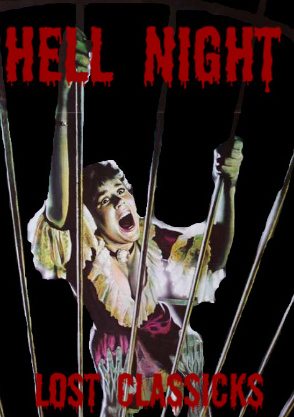
Director: Tom DeSimone
Writer: Randolph Feldman
Starring: Linda Blair, Vincent Van Patten, Kevin Brophy, Jenny Neumann
Rating: R (USA), 18 (UK), R (Australia)
Of all the slashers to be unleashed in the early eighties, few had as a distinctive look and feel as Hell Night, Tom DeSimone’s gothic thriller that replaced the splatter aspect with old fashioned atmospherics. Starring Linda Blair, the notorious child actress who had masturbated with a crucifix in The Exorcist, and hosting a selection of future successes, the movie was less of an exploitation and more of a throwback to the days of Hammer and Roger Corman. Utilising the haunted house formula, a rarity for the slasher genre, Hell Night used striking cinematography and lavish production designs in place of Tom Savini-style gore effects, a decision which some horror fans applauded whilst others felt short changed. Released in the summer of 1981, amidst the height of the slasher boom, Hell Night was greeted by an enthusiastic audience and has since remained a cult favourite.
Tom DeSimone was born and raised in Cambridge, Massachusetts, and developed a taste for cinema at an early age. Having been bedridden when he was ten-years by a rheumatic fever, his father purchased a projector and a selection of films to keep him entertained, which soon progressed into a passion for storytelling. He soon began making his own 8mm shorts films and later studied drama at Emerson College in Boston, before progressing to the University of California in Los Angeles (UCLA), where he made the award-winning short Wooden Lullaby. After graduation, he landed a job as an editor on various educational films before landing the position of post production supervisor for Bosustow Productions in LA, where he directed another successful short, One Special Dog. He then formed his own company and began directed X-rated films under the pseudonym Lancer Brooks, eventually making the acquaintance of a producer, Bruce John Curtis, at a New Year’s Eve party. Their first collaboration was the adult comedy Chatterbox, the outrageous tale of a beautician (the late Candice Rialson) with a talking vagina, which would be distributed by American International Pictures in 1977. After several more explicit efforts (including the dubiously titled Gay Guide to Hawaii and Wet Shorts), DeSimone and Curtis reteamed once again with the intention of developing a low budget horror film together.
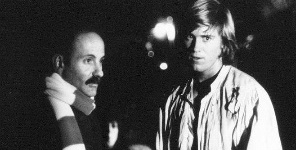
Hell Night centred around a group of pledges from Alpha Sigma Rho who are dared by two of their fraternity brothers as their initiation to spend a night in the supposedly cursed Garth Manor where, years earlier, the master of the house had murdered his family in front of his son, before hanging himself, only for the son and father to disappear. Legend has it that the son still haunts the mansion and will take the life of anyone who dare enter. Among the small group of pledges that have been lined up for the slaughter are ‘final girl’ Marti (Blair) and Jeff (Peter Barton, later a victim of Friday the 13th: The Final Chapter). With the premise in mind, first-time writer Randy Feldman (who would find success in later years with Tango & Cash) developed the screenplay, taking various slasher clichés and incorporating them into a concept not dissimilar to William Castle’s House on Haunted Hill, with a dose of old Universal classics thrown in for good measure. Whereas most slashers had taken notes from Psycho, Hell Night had sought inspiration from even older chillers. The script, and the filmmakers’ enthusiasm, caught the attention of independent producer Irwin Yablans, whose prior experience in the genre had included the hugely successful Halloween and the vastly underrated Fade to Black.
Curtis already had his leading lady in mind when Feldman delivered his script, having previously worked with Blair in the notorious 1974 television feature Born Innocent, a film which had caused much controversy due to a scene in which the star was raped in the showers with a mop handle. With Blair attached, Curtis approached DeSimone about directing the feature, knowing that Yablans had a reputation for allowing his filmmakers artistic freedom and would provide the director with the perfect opportunity to move away from the adult industry and into more commercial territory. Once both DeSimone and Blair were convinced that Hell Night would not just be another blood and guts Friday the 13th clone, pre-production was soon underway. The principal lead role of Jeff went to twenty-four year old Barton, who had been suggested by his agent but was contemplating retiring from acting. The producers met him for lunch and convinced him to take the role, which would later lead to work on the likes of Burke’s Law and Sunset Beach.
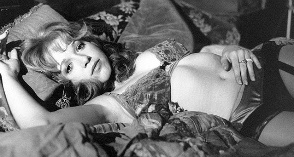
DeSimone’s contribution to the script was the decision to make the fraternity party fancy dress, so when the action moved inside the mansion the characters would not be walking around cobwebs and chased by ghosts in jeans and t-shirts. The crew boasted a few members who would later enjoy successful careers in their own right. Executive producer Chuck Russell would make his directorial debut in 1987 with A Nightmare on Elm Street 3: The Dream Warriors, later followed by The Blob, The Mask and The Scorpion King. Swedish cinematographer Mac Ahlberg, who was already a twenty-two year veteran of the industry, would work on some of the most successful genre pictures of the eighties (Ghoulies, Re-animator, House, From Beyond) whilst the makeup crew included Ken (Swamp Thing) Horn, Pam (The Hitcher) Peitzman and John (Maniac Cop 2) Eggett. Post production would later involve editor Tony (Purple Rain) Di Marco and composer Dan (The Lawnmower Man) Wyman.
The filming of Hell Night took place over approximately six weeks through November and December 1980 in a gruelling shoot that would involve all nights. The movie was shot on three principal locations. The exteriors of Garth Manor were filmed at Kimberly Crest House, a 7,000 square foot eighty-four year old French chateau in Redlands, California whose owner, Mary Kimberly Shirk, had passed away the previous year and was set to become a museum. But the estate refused to allow the crew access inside to film so they were forced to move the production to an old house in Pasadena where they were given permission to redesign to create the interiors of the mansion. The sequences on the rooftop and the tunnels underground were shot on a soundstage at Raleigh Studios in Hollywood. DeSimone and Ahlberg had decided prior to filming that they wanted to give the film a natural look by avoiding any artificial light, with the characters illuminating each room with candles. This forced the filmmakers to light every shot in a way that would be as minimal as possible so as not to saturate the sets.
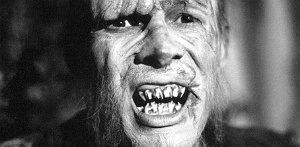
The opening shot of all the pledges partying and the camera moving through them in one take took about four hours to prepare. This two and a half minute sequence, which would feature no cuts (perhaps as a reference to Yablans’ previous success, Halloween, which also featured an impressive opening sequence), was shot outside Redlands University, whilst the party inside was filmed in the lobby of a Hollywood apartment block that DeSimone had visited. The production hit a major obstacle during the first week of filming when a bystander who had been watching the shoot stole the DeSimone’s script, which included all of his director’s notes. Despite offering a reward for its safe return, DeSimone was forced to recreate his shots from memory and from then on demanded a closed set. Even though Hell Night is noted for its lack of bloodshed, there had been one special effect shot that would have satisfied the gore fans, though sadly the MPAA insisted that it be severely censored. This involved the decapitation of May. Instead of the head falling to the floor, DeSimone had decided that he wanted to try something a little different and so had the axe-wielding monster hold her still twitching head for a few seconds afterwards, revealing her moving eyes and open mouth. This was achieved by a hole being cut into the wall with which the actress, Jenny Neumann, would place her head through. A prosthetic body was then placed below her, with the artificial neck created from mortician’s wax, which the axe could simply slice through.
Despite all of the difficulties that had dogged the production, the filming of Hell Night was a surprisingly enjoyable experience for all involved. Many of the actors would enjoy various genre appearances throughout the rest of the decade, with Neumann starring in the hit science fiction show V and Blair enjoying success in Chained Heat and Savage Streets. The movie was released theatrically on August 28 1981 and became another victory for Yablans, who would soon follow it with a return to the Halloween series. Over the years, Curtis has expressed interest in either a sequel or a remake to Hell Night, despite the fact that the Garths were not created as ‘re-usable monster.’ He even considered bringing back Blair, who would now play a school teacher, but as his features still operate outside of the union and DeSimone is a member of the Director’s Guild he would not be returning. But at this time, a return to Garth Manor has not been approved.
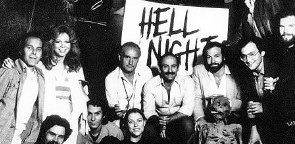

4 Responses to The Making Of Hell Night (1981)